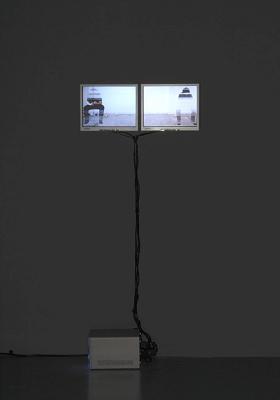Time-based media art: artwork containing audiovisual components that rely on playback mechanisms or systems for decoding, and that are typically engaged with other elements as an installed, interactive and/or performed experience
In September 2013 I arrived at the Archives to commence the inaugural 9-month National Digital Stewardship Residency designed by the Library of Congress and funded by the Institute of Museum and Library Services (IMLS). Directed at the curatorial and conservation obstacles time-based media art imposes on museum workflows, I was tasked with developing strategies for handling the digital assets that make up these kinds of works, with particular focus on how they might best be placed in a trustworthy digital repository environment.
Jenny Holzer’s For SAAM (Smithsonian American Art Museum), and Siebren Versteeg’s Neither There nor There (Hirshhorn Museum and Sculpture Garden) are just two examples of time-based media art that rely on digital assets to operate and that can be found in collections across the Smithsonian.
Through acquisition, installation, storage, and later re-installation, these works require technical evaluations and monitoring generally laid out in digital preservation strategies, which have not typically been cemented in museum procedures. At the same time, the variable, iterative, and subjective nature of these works necessitates the use of granular, yet scalable policies for describing, representing, and preserving their essential elements, behaviors, and variability. For these reasons, the standard assumptions surrounding documentation, authenticity, and custodial roles in the realm of digital preservation fall short of meeting the needs of time-based media art.
As part of my residency I am in conversation with curators, conservators, registrars, and gallery staff across the Smithsonian who have been participating in the Time-Based Media Art Working Group efforts. They have been looking internally and externally for resources and expertise in handling these types of works in order to fit the needs of their own collections. From these discussions I am developing higher-level procedures based upon preservation practices and current museum approaches.

It is important to note that the Smithsonian is particularly unique in this conversation, in that it represents a number of designated communities (units) with disparate collections, missions, and infrastructures.
With all of these things in mind, my ultimate goal is to produce baseline ingest, storage, and access policies for specific classes of time-based media artworks (web, video game, generative, etc.) with supplemental suggestions for the more granular, yet flexible guidelines based off variability and intended behaviors (installed, networked, performed, etc.). Through my deliverables I hope to add to the resources to be considered not only within the Smithsonian, but in other institutions collecting digital time-based media art as well.
Finally, since artists have and will continue to produce works using an assortment of both obsolete and emerging software, processes, and tools (whether intentional or not), it is necessary to remain flexible with regard to digital preservation approaches across museums. Priority should be placed on strategies that are adaptable, with the understanding that continued learning and collaboration will be essential in maintaining authenticity in the future re-creations of these works.
Related Resources
- Time Based Media Art Working Group, Smithsonian Institution
- Erica Titkemeyer blog
Produced by the Smithsonian Institution Archives. For copyright questions, please see the Terms of Use.

Leave a Comment